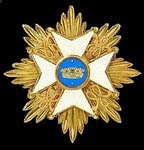Chef Prinz Friedrich Franz von Braunschweig, from 26th December 1745. Colonel as of 1st March 1751 and later Major General. Died Hochkirch 14th October 1758, aged 26. No chef from 1758-1763.
First raised 1740 as the House regiment of Braunschweig, which it was for 30 years.
In 1756 the regiment was kept on the old establishment of 1220 men. It was mobilised on July 25th in Far Pomerania under Lieutenant General the Hereditary Prince of Hesse-Darmstadt to reinforce the Prussian Corps there. At Prague on 6th May 1757 the regiment was on the right wing, second line under Hautcharmoy and took part in the breakthrough south of Kej after Winterfeldt's first attack was thrown back and Winterfeldt wounded. Prinz Franz was at its head when it followed IR18 in storming across the long causeway towards Mount Tabor and into the fighting in the Rokenitz Brook. Suffering heavy losses it advanced to near the city of Prague by the end of the battle. The King greatly approved. (Duffy Army of Frederick the Great 1st Edition (henceforth AFG1) shows losses of about 30%.) The grenadiers were at Kolin on the 18th June and lost their commander, as well as about 25% rank and file as casualties (AFG1). IR39 joined Bevern for the push into Lusatia and Silesia and one battalion fought in the defeat at Breslau on November 22nd. The 1st battalion of IR39 fought at Leuthen on the second line of the right wing, losing about 25% casualties (AFG1) but capturing 14 enemy cannon.
In 1758 the regiment was with the King besieging Olmütz. On returning from Moravia it defended the vehicle park from repeated attacks. At Hochkirch on October 14th it was with Retzow's corps on the left flank and helped protect the army's withdrawal. Its chef Prinz Friedrich Franz was killed by a cannonball on the right wing of the army and his horse with its very highly decorative saddle ran between the armies in panic for some time after his death. Lack of recruits prevented the regiment being further employed that year.
In 1759 IR39 returned to the King's army but saw little action at Landeshut or Schmottseiffen.
In 1760 both battalions joined Prinz Heinrich's army, which gathered in May between Sagan and Lauban. The grenadiers lost 389 men at Liegnitz on 15th August; they were stationed on the left wing. (AFG1 shows about 50% casualties.) On September 17th, along with IR35, the regiment was involved in a fierce battle at Hochgiersdorf and captured 17 cannon.
In the first months of 1761 IR39 was with the King's army in Saxony, and surrounded by six times the number of enemies at Altenburg but managed to escape to Leipzig without loss. After being in the camp at Bunzelwitz the grenadiers took 5000 wagons and 1800 prisoners at Gostyn. The rest of the regiment followed to Pomerania on November 14th and took the fortifications at Spie on December 12th. An exhausting march to Saxony via Stettin followed. The regiment was stationed in Neisse from April 1762. In 1763 it consisted of 561 native Prussians, 211 Saxons and 1098 "foreigners". It was one of the regiments most highly favoured by the King after the war. Christopher Duffy (AFG1) says: "Almost three-quarters of the complement were foreigners. Fought well in action but suffered heavily from desertion. Severe losses in Pomerania 1761".
And this was the uniform in 1756:




















